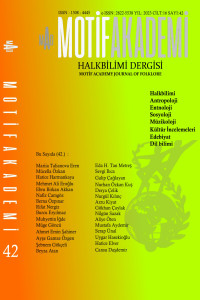HEREKE FABRİKASINDA ÜRETİLEN BAZI İPEK DOKUMALARDA RENK, DESEN, TEKNİK ÖZELLİKLER
COLOR, PATTERN, TECHNICAL PROPERTIES OF SOME SILK WEAVES MANUFACTURED AT THE HEREKE FACTORY
Author(s): Ayşe Gamze Öngen, Şebnem GökçeliSubject(s): Cultural history, Visual Arts, 19th Century, The Ottoman Empire, Sociology of Art
Published by: Motif Halk Oyunları Eğitim ve Öğretim Vakfı
Keywords: Ottoman Weavings; Silk Fabric; Hereke Factory; Jacquard; Çatma Velvet;
Summary/Abstract: Fabrics woven with silk yarn were used in the clothing of the palace people and high-ranking people in the Ottoman Period, in the places where they lived. One of the first large factories of the 19th century Ottoman weaving industry, Hereke Fabrika-i Hümayunu was established during the reign of Sultan Abdülmecit. Hereke Factory, which was established by Dadyan brothers in Hereke town, was put into operation in 1843. Hereke Factory started to work on behalf of the palace in 1845, after being granted to the sultan. Silk fabrics produced for upholstery and drapery in Ottoman palaces and mansions were woven in Hereke Fabrika-i Hümayun. Jacquard looms were brought to Hereke Factory from France in 1850 and the Kemhahane department was opened and work began. Hereke Factory is an important business that makes retail sales, as well as the first establishment, that received great awards in the international arena with its products. In 1902, broadcloth, serge and yarn departments, woolen weaving in 1905, fez department in 1908, undershirt, wool and silk carpet workshops Hereke It has been added to the factory. Hereke Factory was transferred to Sümerbank management in 1933, to National Palaces in 1995, and to Yıldız Palace today. Silk fabrics woven in the Hereke Factory were presented to the Palace and its environs, as well as to foreign dynasty members and ambassadors, and reached the European palaces. Western influences are seen in the composition of Hereke silk weavings, and 143 different patterns have been identified in these weavings, where orientalism and multicolor are used. Many motifs such as plant and animal motifs, vases, musical instruments, geometric arrangements, Rumi, Chinese cloud can be seen in the patterns on the fabrics. It is produced in velvet fabric as well as silk fabric in Hereke factory. The variety of different weaves and rich colors, also seen in Hereke silk fabrics, the late Ottoman silk fabric collection, impresses the audience. However, in these weavings, which create a strong visual impact, there is no style other than quality. In this context, it is important to investigate and examine these silk weavings in terms of pattern, color and production technique in order to transfer the Hereke silk woven fabric collection, which is one of our cultural assets, to future generations.
Journal: Motif Akademi Halkbilimi Dergisi
- Issue Year: 16/2023
- Issue No: 42
- Page Range: 836-848
- Page Count: 13
- Language: Turkish

